Love on the Rocks: Hiking Italy's Alta Via 2

'The Alta Via 2's well-kept trails lead high into the Dolomites, where trekkers can climb sheer cliffs protected by cable-and-ladder via ferratas.…'
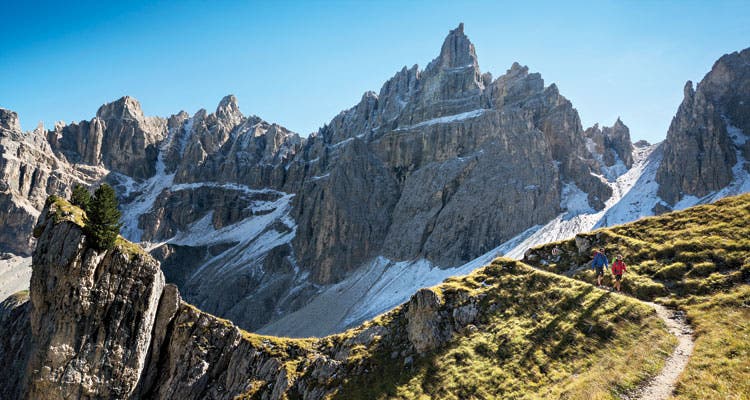
The Alta Via 2’s well-kept trails lead high into the Dolomites, where trekkers can climb sheer cliffs protected by cable-and-ladder via ferratas. (Patitucciphoto)
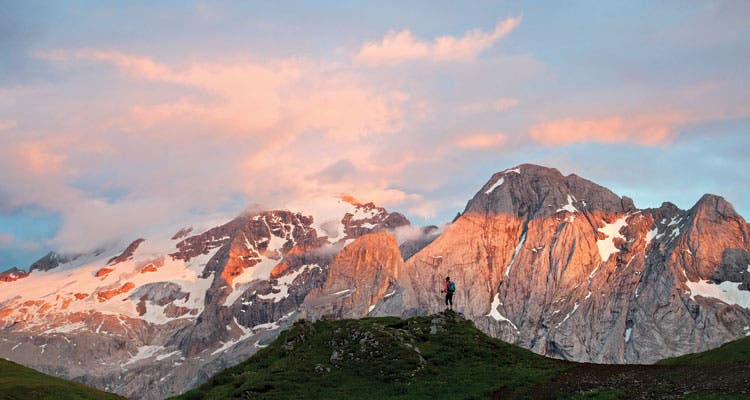
Last light on the Marmolada (Patitucciphoto)
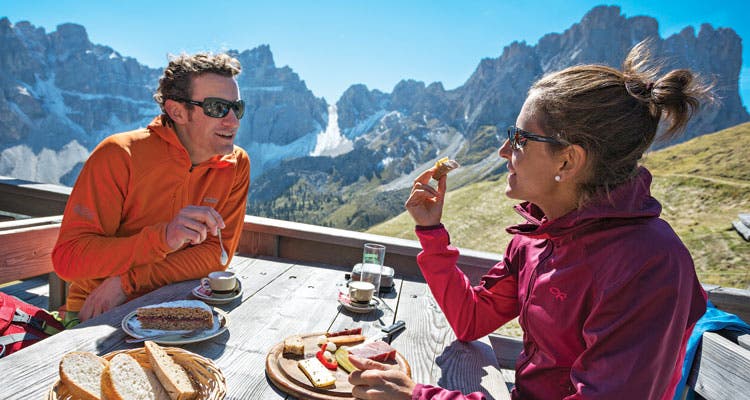
Hungry hikers can stop at the Medalges -Alm for espresso and speck (day one of the author’s route). (Patitucciphoto)
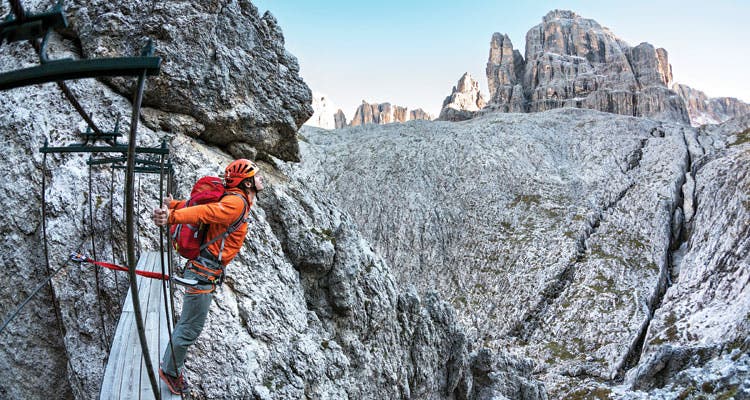
The author does his best Kate Winslet Interpretation on the airy bridge connecting Exner Tower to Sass Masores. (Patoticciphoto)
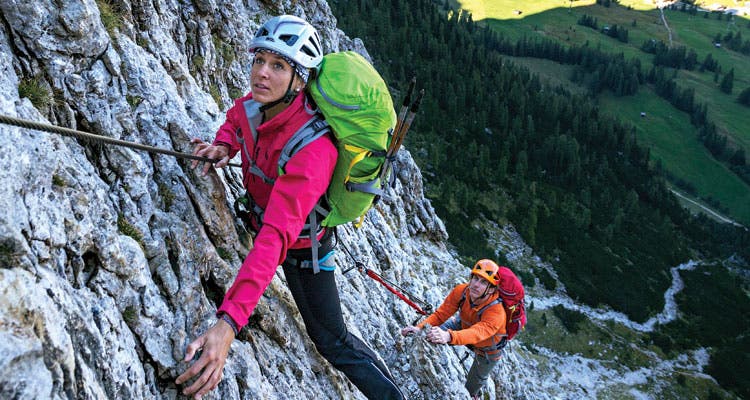
Big handholds and beginner-friendly safety gear make via ferratas like the Brigata Tridentina accessible to trekkers of all skill levels. (Patitucciphoto)
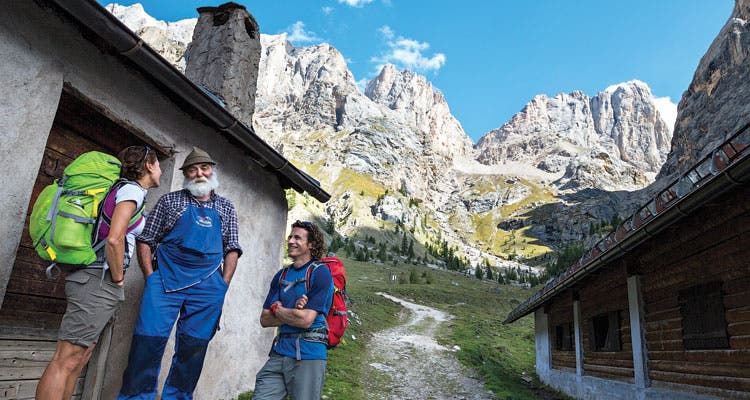
A local farmer chats with hikers beneath the Marmolada. (Patitucciphoto)
When I was 23, I might have fantasized about being on a trip just like this one: dreamy alpine terrain in the heart of Europe, adrenaline-fueled climbs, gourmet food served with a view, and, because I was a young man and an optimist and maybe a little naïve, a gorgeous woman at my side.
Ten years later, I have it all on Italy’s Alta Via 2—from the jagged Dolomites with their cliff-hugging via ferratas to the homemade rifugio dinners to Jen, literally an Italian model with brown eyes, a perfect smile, and legs and lungs forged by ski-mountaineering races all winter and skyrunning all summer. Fantasy come true? In every way but one. I just started dating someone back in Colorado, which makes things a little more complicated than 23-year-old me could have imagined.
A lot more complicated, I realize, after our first trailside photo shoot. Photographer friends Dan and Janine Patitucci invited Jen to join us on the trek as a trail model—I was there to write, not because I look like Brad Pitt—and we stop regularly to take photos. Now this may shock you, but the best pictures are not typically the result of spontaneity. There’s waiting for good light, waiting for clouds to clear, changing clothes to better contrast with the scenery, walking a little off trail, re-walking the same section of trail one time, two times, 27 times to get the right shot.
So here I am, staring at the soaring limestone pinnacles of the Dolomites, looking the other way as Jen drops one pair of pants on the ground and slips into another.
“These are the occupational hazards of an outdoor writer,” I joke while she changes behind me on the trail. “Rockfall, grizzly bears, lightning strikes, keeping some sense of composure as beautiful Italian women you’ve just met undress a few feet away.” She laughs. Am I flirting? Nah. I would try to make any new friend laugh in a situation like this, regardless of gender or attractiveness or muscle tone in her gazelle-like legs. Really.
As we walk the trail, cutting across grassy balds butting up against bone-white peaks, Jen and I chat, I joke, I try and fail to learn even survival-level Italian, and we get to know each other a bit. Maybe we flirt some more? Maybe she likes me?
If you’re single—or remember being single—maybe you recognize my predicament. Am I wrong to be tempted?
Hilary and I haven’t even had the are-we-officially-boyfriend-and-girlfriend discussion yet back in Colorado. We’ve just spent a lot of time together. So far, I’ve been holding back and trying to take it slow, even though I know where I want it to go (assuming I don’t blow it). Or at least I thought I knew. Hilary is beautiful, considerate, kind, smart, interesting—a blonde girl who loves books, midnight bike rides, moonlight rock climbing, and running down mountain trails in thunderstorms. Before leaving for Italy, I sat across from her at a wine bar and listened to her talk—and couldn’t believe she seemed interested in me. Me? The luck!
Luck is an interesting thing sometimes, isn’t it?
***
Once on the trail, I had a feeling that I would have either a) liked to have Hilary along with me instead, or b) rather been hiking in a somewhat less romantic place. Between the mesmerizing alpine scenery and Euro-rustic hut system, the Alta Via 2 is a hiker’s honeymoon. The route begins in the Sudtirol, a German-language Italian region that was part of Austria-Hungary until Italy annexed it at the end of World War I. In the rifugios along the trail, and the shops and restaurants on the road-accessible passes where we buy espresso or beer at least twice a day, we hear danke schön and guten morgen as much as grazie and buongiorno—and every once in a while, Ladin, the traditional language still spoken by about four percent of the area’s 500,000 residents.
After a few days in the Sudtirol, the 112-mile Alta Via 2 enters a more Italian-dominated region. But one thing doesn’t change: the Dolomites. The range is actually pretty small—only 121 square miles, or about one-tenth the size of America’s Tetons. But they’re abrupt, towering 3,000 to 6,000 feet over the nearest towns, and getting up into the high peaks isn’t easy. The trails on the Alta Via 2 sometimes gain 2,000 feet in less than a mile. Sweat up, coast down, repeat. You crest dozens of passes, racking up 37,000 feet of elevation gain and loss if you do the whole thing (which takes 10 to 14 days). We targeted the best 50 or so miles, between Passo delle Erbe and Cant del Gal, for our six-day trek.
During World War I, Italian soldiers constructed the first via ferrata, or “iron way,” to help with the movement of troops and supplies through the precipitous terrain. Over time, these routes attracted adventurous travelers, and ladders and cables and iron rungs proliferated throughout the Alps. (Sometimes you clip into cables with harness and leash, sometimes you just use the metal hand- and footholds for better purchase.) The Dolomites alone now have 10 Alta Vie, or “High Routes” (and many more named via ferratas). Although the first one, the Alta Via 1, may be the most famous, the Alta Via 2 is the more exciting: It’s longer, more alpine, has more optional detours, more exposed trails, and more opportunities to take a via ferrata instead of a trail.
Trail signs and markers are abundant along the Alta Via 2, but sometimes confusing. Fortunately, every few hundred feet in the rockier sections, spray-painted red and white flags mark the trail where it becomes faint.
On the second day, my shoes crunch the broken limestone trail through green meadows as we climb the north side of the 8,586-foot Forcella della Roa, where snow has hung tight through early September in the shade of the pinnacles. I carefully step up the steep scree couloir, watching my step on the snowy sections and wishing I’d brought a pair of trekking poles. At the top, the snow disappears and we’re back in the sunlight, with the first view of the limestone fortress of the Sella Massif. From where we stand, the Sella appears impenetrable, a plateau surrounded by steep walls on all sides—and the Alta Via somehow goes up and over it.
During breaks as Dan and Janine plan a shot, change lenses, or wait for the lighting to become “just right,” Jen and I chat. We soon get past the small talk and the subject of divorce comes up, specifically mine in America four years before—it took only an hour at the county courthouse—and hers, which, being in Italy, was much more involved. Divorce has only been legal in Italy since 1970, and in most cases couples that want to get divorced have to be separated for three years first. Not surprisingly, Italians divorce at a much lower rate than Americans (closer to 20 percent, as compared to our 50 percent).
Wherever it happens, talking with someone else about divorce is a bond—it’s a special kind of heartbreak, with a strange and unique addition of shame when you have to sign official papers to legally break up with your former significant other and you first start using the D-word. When you’ve been through it and you meet someone else who has, you know they understand what it’s like, and how it takes a long time to realize you’re going to be OK. You have empathy for each other. Also, you’re probably both single.
Then, if you’re hiking the Alta Via 2 and fueled by twice-daily espresso and endless mountain views, you might wonder: Is my heart pounding 175 beats per minute because of the ascent up to the passo, or because I’m infatuated with a gorgeous European woman and simultaneously remembering the girl back in the States?
When you’re single, you think the hardest thing is finding someone perfect for you. When you find someone who seems perfect, though, isn’t the hardest thing admitting it, and cashing in your chips for that person—regardless of who else might be out there? You have to say goodbye to all the other possible love stories you could live out.
As we walk beneath the sharp peaks, our legs rejuvenated by the latest espresso stop, we also talk about the future. Jen says she wants a family, wants to have children someday, maybe sooner rather than later. She asks if I want children, and I say definitely not now, maybe later, maybe not at all. I’m really excited to do a lot of other things, like traveling and writing, and I don’t want to make time for kids right now.
“Perfect!” she says. “We could have a baby, and you could leave and go travel and I could stay in Italy.”
I laugh nervously. Am I in a Woody Allen movie?
***
The Brigata Tridentina, at mile 39, is one of the most popular via ferratas in the Dolomites, and for good reason: It climbs 1,200 feet in less than a mile from Passo Gardena to an airy finish on a 30-foot-long suspension bridge connecting a vertical formation called Exner Tower to the main plateau of the Sass Masores. From there, you’re a 10-minute walk from a cold Forst beer and hot pasta carbonara at the Rifugio Franco Cavazza al Pisciadu.
I fall into the rhythm of the via ferrata, clipping my leashes into the cables, unclipping when I reach the spots where the cables are bolted into the rock, clipping back in on the other side. It’s a relatively easy process, which is part of the appeal: You don’t need any rock climbing experience to tackle the exposed, sometimes surprisingly steep routes. I continue up, using handholds and footholds through the cable sections and climbing ladder rungs on the steepest sections. The climbing, without the cables, would be mostly class 4 or low class 5, and the route winds up over rock slabs and around steep corners, forging an artful, if artificial, path through a section of the Dolomites that would be otherwise impassable without climbing gear. The cables and rungs, however, make this 1,200-foot section go by far faster than if we had brought a rope and a rack of gear.
Despite its summertime popularity, the via ferrata is empty on a Sunday afternoon in late September. Just us, making our way up hundreds of feet of rock in the shade next to a waterfall. Clipping the cable and stepping onto the old bridge is the last bit of exposure on the Tridentina, and I take a breath and step onto the span with 60 feet of air under my feet. Once sure of the bridge’s sturdiness, I start to clown around, leaning over the abyss and posing like Kate Winslet on the prow of the Titanic, while Jen giggles on the other side and Dan snaps a bunch of photos that will probably never be seen by anyone but us.
We end the day at Pisciadu rifugio, where the dining room windows overlook a scene even more remarkable than usual. The mountains glow with enrosadira, a phenomenon only visible in the Dolomites. The rock here is a unique composition of calcium carbonate and magnesium, and when the late evening sun hits the peaks, they glow a rosy pink, or even purple—similar to alpenglow, but even better. The peaks of the Puez Group light up like hot coals in the darkening sky. Why does this place have to be so damn romantic?
That night, Dan and I benefit from low reservations at the end of the season and have a 36-bed room all to ourselves. I wiggle into my sleeping bag liner, pile on the extra blankets, and play the remarkable day back in my mind. I wonder what Hilary would have thought of that airy bridge. I scroll through my offline phone for photos of her that I saved before the trip. She’s the best person I’d ever met, isn’t she? How sure do you have to be? 100 percent? 95 percent? 51 percent?
***
Rays of late afternoon sun poke through clouds, washing the grassy hillside in gold and stretching our shadows to the east. Around a bend, I see five white sheep balancing on a ridge, then 50 sheep. Bells clang around the necks of a few of them, and a shepherd, about 70 years old with a Santa Claus beard, slowly follows them, his two dogs freezing in place every time they hear his commands and lovely (to an English speaker) Italian curses. I raise one hand and wave to the shepherd, and he waves back.
When you’re far away from everything you know and seeing something magical by yourself, you start thinking about all the people you love and how you wish they could see what you’re seeing. When you get back, you know you won’t be able to explain it exactly as it happened, especially the white-bearded guy making a living just like his ancestors did 300 years ago, watching sheep on a steep hillside. I think about Hilary, how I’ll tell her about it when I get back to Colorado, and how it would be a lot better if she were just sitting here next to me in the tall grass. Of course, if she were here, this would be a far less confusing trip.
For most of the trek, opportunities to be truly alone with Jen are thankfully rare. That’s because most rifugios on the Alta Via 2 are dormitory-style: six to 30 bunks, men and women all in one room, mostly dead-silent, high in the mountains. Even if, say, you were 23 and wanted to sneak out of your bed into someone else’s, and, let’s just say, hypothetically, snuggle with a beautiful person you’d recently met, if he or she was hypothetically receptive to that sort of thing—it would be hard to keep it a secret from everyone else in the room. Which is just as well, given my mixed-up state of mind.
And then we walk into the Albergo Miralago on day four, and it’s basically a hotel—no dorm-style single beds. The four of us get two rooms, one for Dan and Janine, one for myself and Jen. No problem, I think, imagining two full-size beds on opposite sides of the room as we head upstairs.
Jen unlocks the door of the room and pushes it open. She steps inside and starts laughing—at the single, queen-size bed. No couch, no love seat, no other stick of furniture for a virtuous man to lie upon.
We crawl into opposite sides of the bed. I click off the light, lying on my back, not moving, trying not to breathe loudly, trying to not imagine what 23-year-old me would have done in this situation. This is a test, I tell myself, and try to quietly remember and recite the entire St. Louis Cardinals 1985 roster.
But is it a test you can pass or fail? Does anyone ever truly know if he’s made the right decision? If you choose door #1, you’ll never know what’s behind door #2, whether it’s a relationship, a job, or simply where to hike on your next vacation.
On our last day, we stop mid-morning and I order my last doppio tazze, or two cups of cappuccino, and soak up the final view of the Dolomites, all limestone, the only plants growing no higher than an inch tall. Our hike down to Cant del Gal drops 3,600 feet in about 2.8 miles, leaving the spare mountain landscape behind and entering a lush landscape of trees and flowing creeks.
I wonder about the path not taken as I walk the last few miles of trail. Is there some sort of useful metaphor to be gleaned from the trek, between the spikes in elevation and the roller coaster of emotions I experienced? I feel like I’m pulling my head out of the clouds, one step at a time. As I say goodbye to Jen, I finally understand that hiking the Alta Via 2 with her really was a stroke of good luck. It’s a dream trek that always tests your legs and capacity to absorb just one more espresso or beautiful scene—and this time it proved to be a trial of another sort.
But I think I’ve come through it with some clarity. How sure am I that Hilary is the one? There are no percentage points or numerical grades to answer this question. The only honest answer is: enough. I’m sure enough.
Brendan Leonard returned to the Alps with Hilary last summer. It was quite romantic, he says, and he slept much better.
TRIP PLANNER
Getting there: Innsbruck is the closest major airport to Brixen (1 hour and 10 minutes away).
Permits None
Itinerary Most hikers prefer to go north to south and take 10 to 14 days to finish the entire 112-mile trail (Brixen to Feltre). For the author’s 51-mile trek (with side trips), start at Passo delle Erbe and end at Cant del Gal.
Season Mid-June through the last week of September. North-facing gullies can hold snow until late June, and crowds thin out starting in early September. Avoid August, when most Europeans are on vacation.
Rifugios Reservations at rifugios can be tricky; many hut operators are difficult to reach by phone. Holimites (holimites.com) arranges custom itineraries and handles reservations, as well as transportation to and from trailheads and the Innsbruck airport. Plan on roughly 50 to 60 euros per night per rifugio (includes bed, dinner, and breakfast; add another €10 a day for splurging on trailside espresso and other treats). Most huts are dormitory-style with rooms sleeping four or more people. Some huts do have private rooms, which fill up to eight months in advance. If booking on your own, many huts have discounts for American Alpine Club members (americanalpineclub.org). Many rifugios have showers.
Camping Allowed, but not officially encouraged. Tents must be set up after dusk and taken down before sunrise. Water sources can be scarce up high, but many rifugios have water fountains outside.
Via ferratas Scared of heights? You can detour around every via ferrata on the route.
Gear Lightweight sleeping bag liner (rifugios have blankets); approach shoes; via ferrata kit (harness, lanyard, helmet; you can rent one at Snow Service in Cortina for €47 for 6 days)
Maps Tabacco 1:25,000 maps are $13 each, omnimap.com; also available at rifugios along the route: #30 Bressanone/Brixen; #6 Val Di Fassa; #22 Pale di San Martino; #23 Alpi Feltrine-Le Vette-Cimonega
Guidebook Trekking in the Dolomites: Alta Via routes 1 and 2, with Alta Via Routes 3-6 in Outline by Gillian Price ($23; amazon.com)
Guide service Holimites offers custom guided and self-guided itineraries, starting at €975 (holimites.com).
Info dolomitesport.com